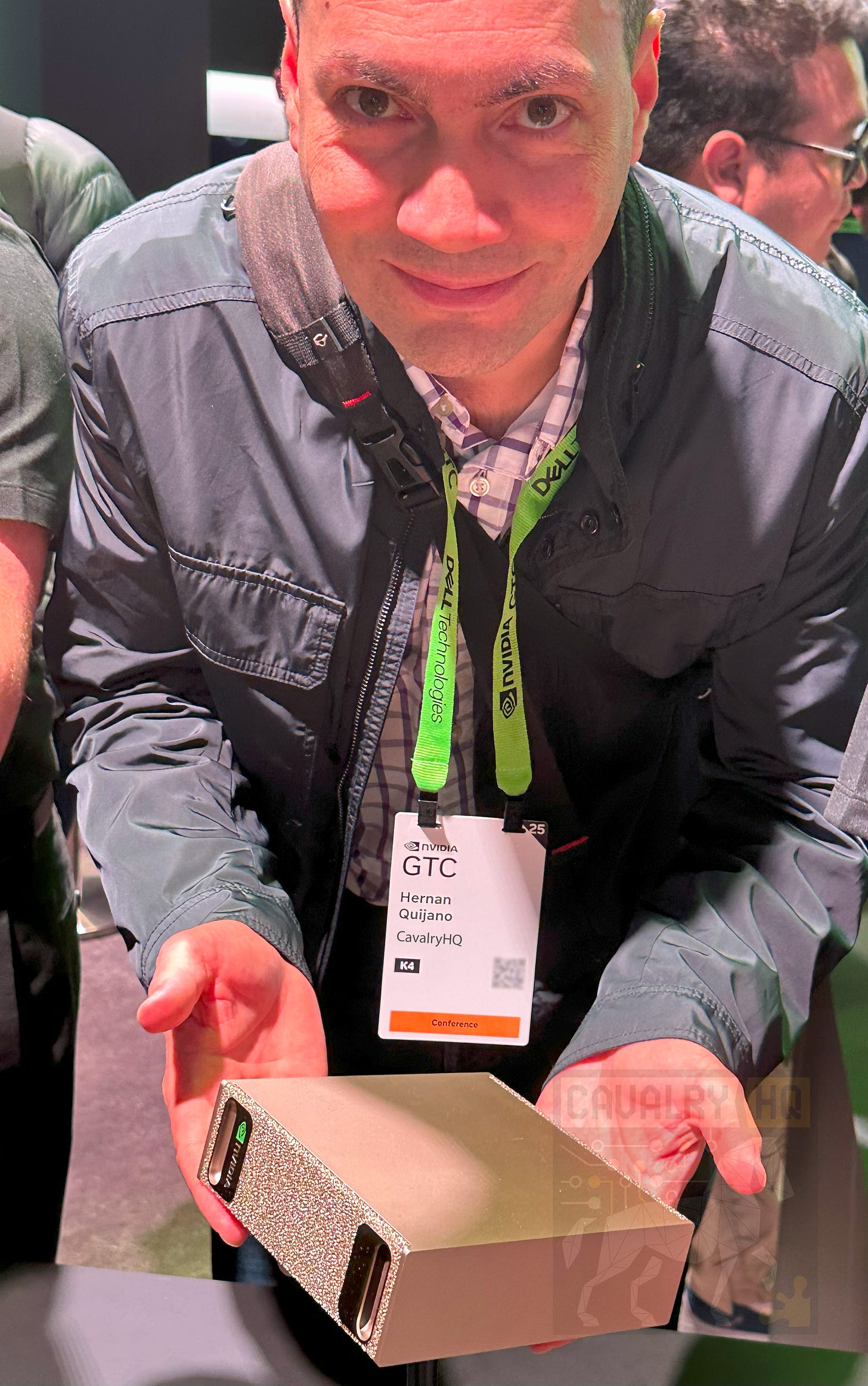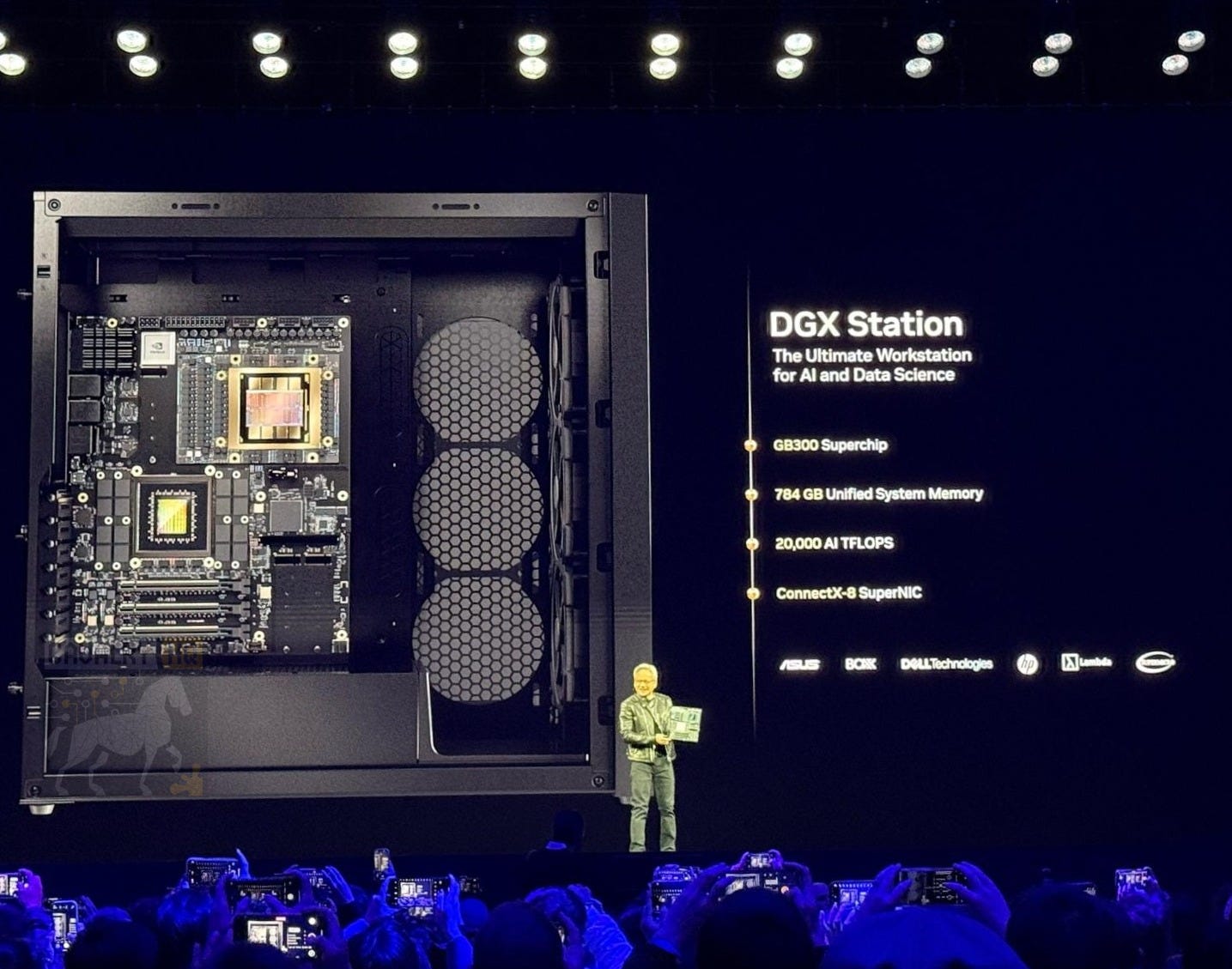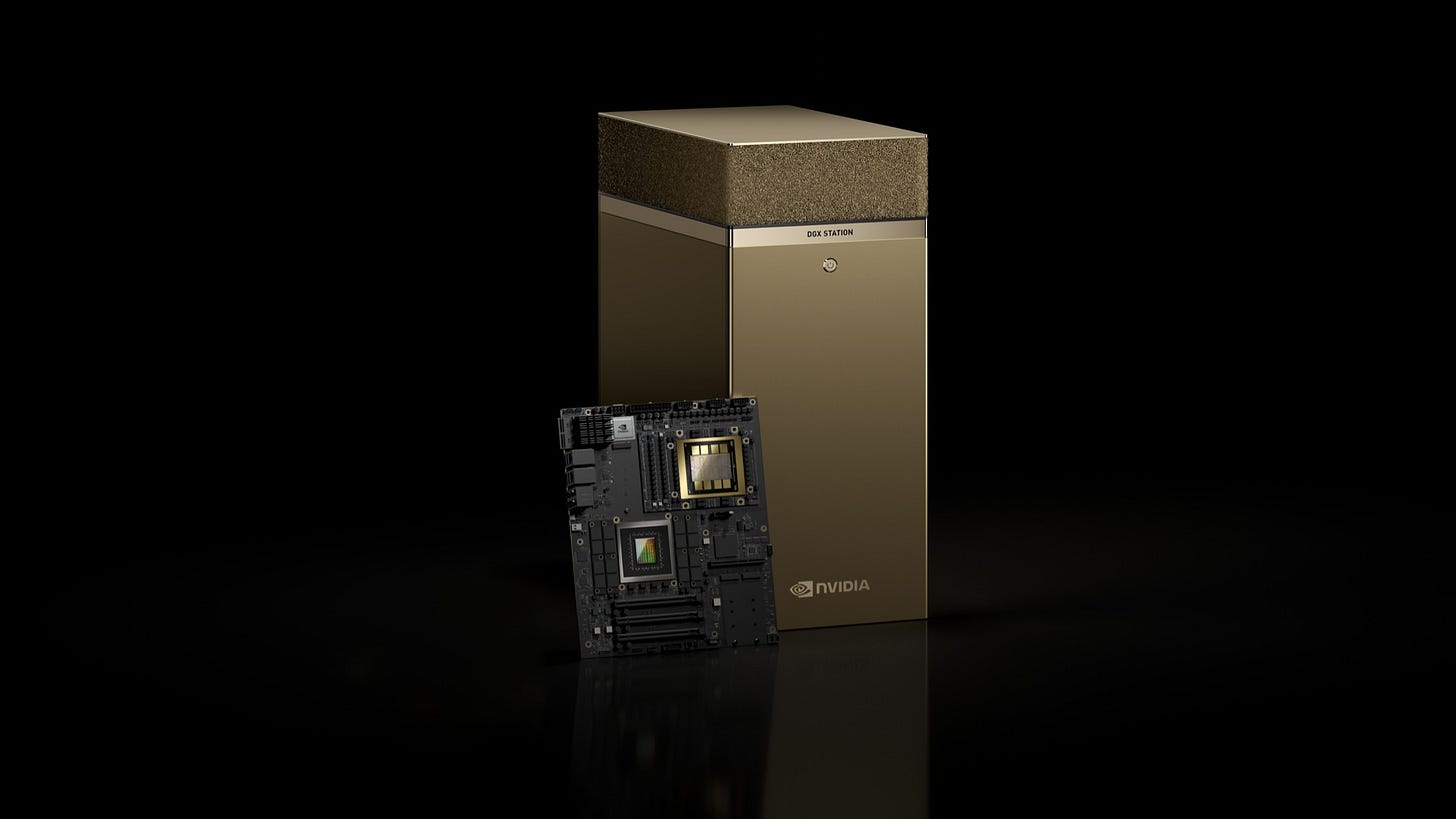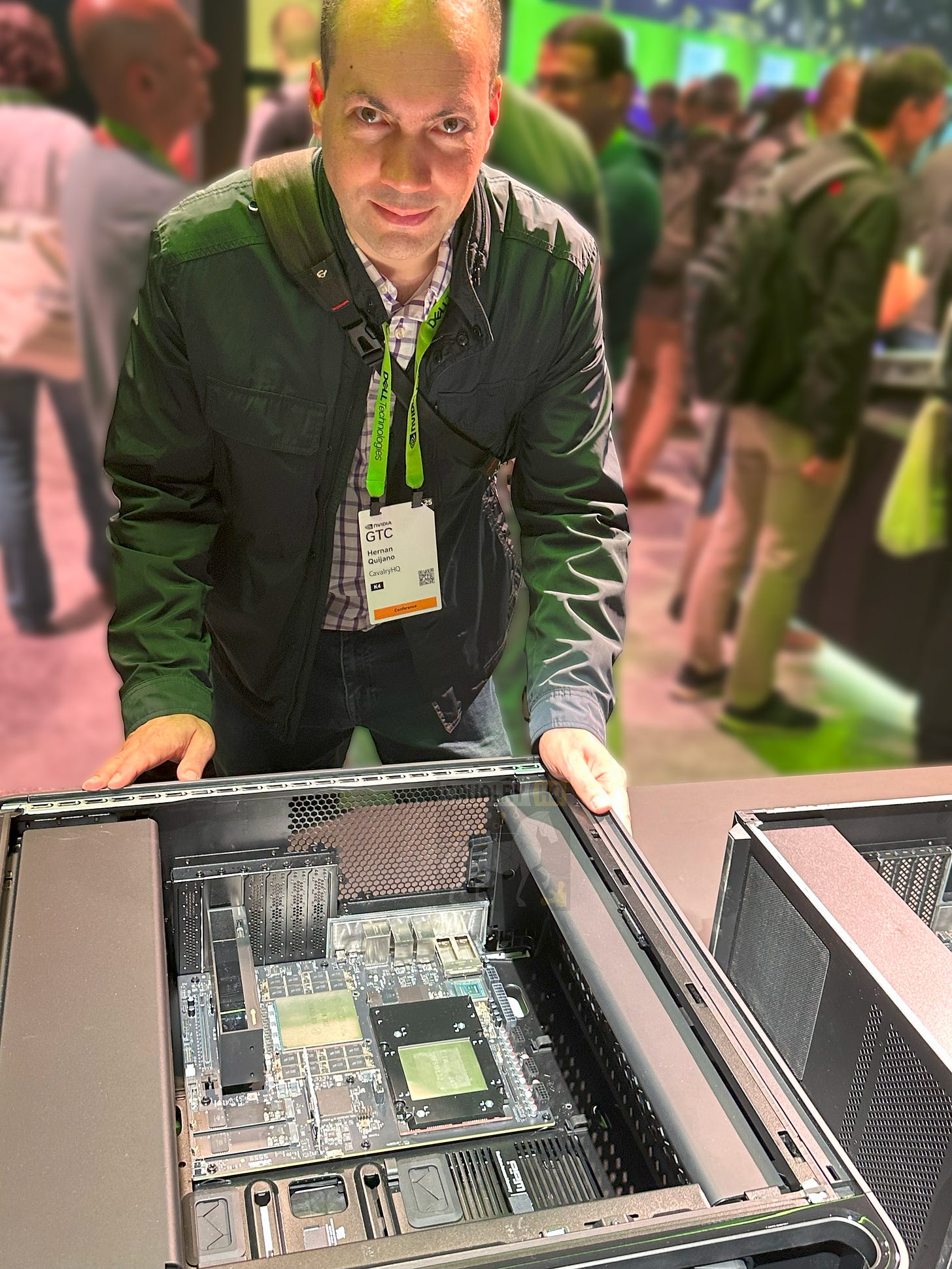Nvidia DGX Spark and DGX Station, redefining the Future of AI Workstations? Part 2/3
Making sense of Nvidia's latest Workstation announcements at GTC 2025 and exploring their impact on the workstation landscape.
Be sure you already checked Part 1: The background
Part 2: Meet the 2025 Nvidia DGX <Workstation> products
For local development, as mentioned above, the top Workstation OEMs created with Intel and Nvidia, custom Data Science Workstations (later called: “A.I. Workstations” and such systems have been updated to newer generations of CPUs, GPUs and Software tools to make Developers more productive.
At Nvidia GTC, Jensen Huang announced the 2 new members of the DGX family: DGX Spark and DGX Station. I have to admit, just hearing the W-word coming out of a CEO brings chills down my spine and it is THE most boring drinking game I have ever come up with! :-D
Let’s talk about the new products:
DGX Spark
Formerly known as Project DIGITS, now officially called DGX Spark. Don’t be fooled by its Mini-PC form factor, the DGX Spark is very mighty, powered by Nvidia GB10 Grace Blackwell chip that combines the Grace CPU, Blackwell GPU and 128GB of Unified Memory. This means that both CPU and GPU can access the same memory space, reducing costly transfer operations over PCIe buses, that while great for graphics cards and peripherals, are not fast enough for XPU compute, where there needs to be collaboration between both compute subsystems. More on memory architecture later.



Before we go further, let’s talk about the bigger brother… Please set the green carper for the…
DGX Station
If you are a minimalist, this beast is not for you. The DGX Station is a Full-Tower Workstation, a Form-Factor designed for expansion and to have all the thermal management needed to unleash the last drop of performance out of any silicon on it. Obviously, it is way more powerful than the DGX Spark. How much? we don’t know for sure; we will have to wait for benchmarks when it is available. Having said that, it is significantly more capable, judging by its specs and Nvidia claims of 20X AI theorical perf vs DGX Spark. We will compare them later; you probably remember this picture from my LinkedIn post; I had the pleasure to witness this live:
About the system itself, this is the DGX Station (2025 Edition)
I specify that this is the 2025 Edition since there have already been previous 2 versions of the DGX Station:
The first one in 2018, powered by a single (and already old for its time) Intel Xeon server CPU (20 cores, 2016 Broadwell architecture) and 4x Nvidia V100 GPUs. AI theorical throughput: 500 TeraFLOPS (Mix Precision)
The second one in 2020, powered by a single AMD EPYC 7742 (64 cores, Rome architecture) and 4x Nvidia A100 GPUs. AI theorical throughput: 2,500 TeraFLOPS (unknown precision, assuming FP16)
And now, the new DGX Station (2025 Edition), now powered by an Nvidia GB300, that combines 2 components: an Nvidia Grace CPU (72 CPU ARM cores) and an Nvidia Blackwell GPU. Such GPU does not have any graphics/display capabilities, so you will need an Nvidia discrete RTX Pro graphics card on a PCIe port. Well played Nvidia! AI theorical throughput: 20,000 TeraFLOPS.
Overwhelmed by all the specs? I think this chart will help you appreciate the progress Nvidia has done in such a short period of time:
The Memory Subsystem - an architectural note
Before we talk about the business side of things, I feel the need to make a clarification, it seems that there is a significant difference between the memory architecture of the DGX Spark and the DGX Station.
There are 2 concepts at play here: Unified Memory and Coherent memory.
Unified Memory refers to the fact that multiple devices (CPU and GPU) can access the same memory space, in other words they share memory. This has advantages since this avoids expensive (time consuming or just inefficient) copy operations of data between CPU memory (RAM) and GPU memory.
Coherent Memory on the other side, happens when the computing system, which has multiple memory levels on its hierarchy (i.e. cache, RAM) assures that all copies of the same data stay synchronized, so when any part of the system access certain variable, they all have the same information and when one changes, they all do.
The DGX Spark has 128GB of Unified Memory, so CPU and GPU on the GB10 can access the same memory and address such memory space.
The DGX Station on the other hand, claims to have a total of 784GB of Memory, but it a combination of 496GB of LPDDR5X RAM for the Grace CPU + 288GB of HBM3e for the Blackwell GPU. In this case, the 2 memory subsystems are Coherent and Unified, thanks to the NVLink-C2C Interconnect.
This can mean one of two things:
Option 1: The boring but OK scenario. There is pretty much a copy of all the 288GB of GPU Memory on the CPU RAM and when one changes, they both do. Also known as traditional coherence. Not the most efficient since 2 memory spaces duplicate and synchronize data, but it’s the traditional approach for separate subsystems.
Option 2: The paradigm shift! The NVLink-C2C Interconnect’s bandwidth (BW) is 900GB/s, this is 2.3X the CPU to RAM BW of 396GB/s. If the memory is truly Unified, the CPU would be able to read the GPU VRAM without making a copy to CPU RAM. The GPU might maybe feel a little tickle, but it should not affect performance too much since the HBM3e has an insane 8TB/s of BW. No, I won’t compare this to school buses, nor football fields, just picture that is 20X the BW of CPU-to-RAM. Also, this would be an extremely efficient use of memory while eliminating PCIe bottlenecks; that would be an architectural achievement to say the least.
Not only Nvidia’s slide claims the memory is Unified, but also the Dell launch blog claims the same.
The last time I saw an attempt to alter the memory hierarchy this much was with Intel Optane!
Ok, let’s switch gears and talk about the business side.
The role of the OEM Partners: “Together we go far!”
It was interesting to see that the DGX Station (the golden tower) shown at the keynote was not…
Let’s continue the conversation
Can I help you bring these products to market? Would you like an in-depth review of your latest Workstations?
Do you want an independent voice on your next salesforce training or webinar?
Do you need help selecting the best Workstation solutions for your company?
I’m one click away…
References:
Nvidia DGX Station (2018): White Paper: https://images.nvidia.com/content/newsletters/email/pdf/DGX-Station-WP.pdf
Nvidia DGX Station (2018): Data Sheet: https://www.nvidia.com/content/dam/en-zz/Solutions/Data-Center/dgx-station/dgx-station-print-explorer-datasheet-letter-final-web.pdf
Nvidia DGX Station A100 (2020): Data Sheet: https://www.pny.com/en-eu/File%20Library/Professional/DATASHEET/DGX/DGX_Station_A100_Datasheet_PNY-WEB.pdf
Nvidia DGX Spark: https://www.nvidia.com/en-us/products/workstations/dgx-spark/
Dell Blog - Nvidia GTC coverage: https://www.dell.com/en-us/blog/pushing-boundaries-driving-ai-innovation-at-every-scale-with-dell-pro-max/











